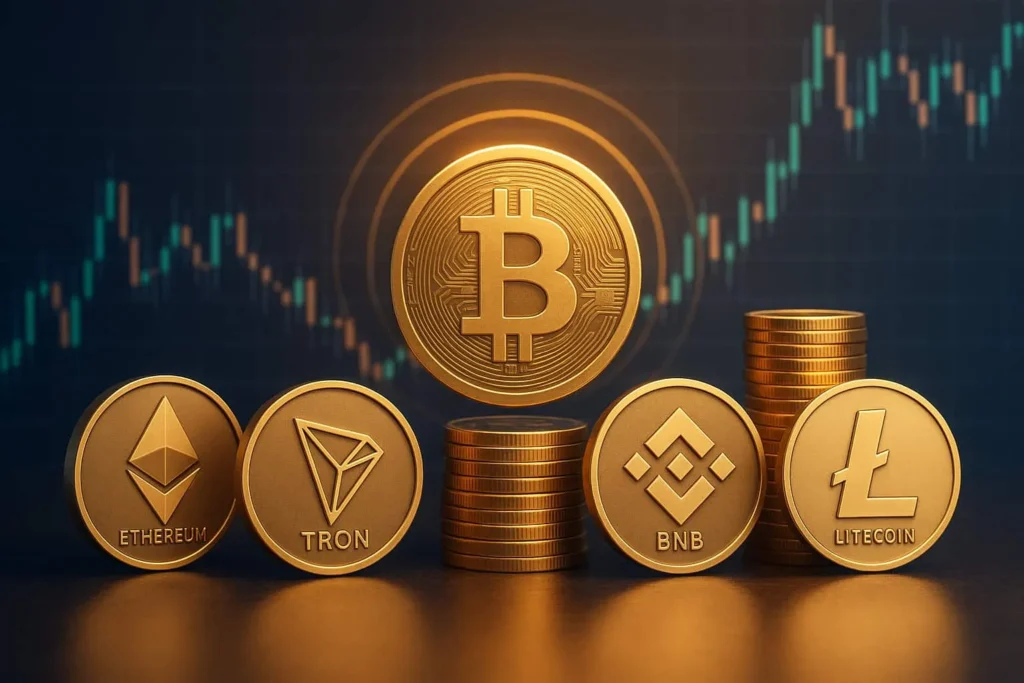The crypto market has a way of reminding investors that volatility is not a glitch; it’s the feature that powers opportunity. In the wake of an unexpected market-wide selloff, a growing wave of altcoin accumulation has started to take shape. This accumulation phase is quietly unfolding beneath the noise of price charts and social feeds, as long-horizon participants reload positions, new entrants build starter stakes, and algorithms rebalance toward beaten-down assets. While the immediate shock of a drawdown can cloud judgment, the period that follows often sets the stage for the next sustained move. Understanding why accumulation happens, who drives it, and how to participate prudently can transform a scary dip into a disciplined strategy.
This article unpacks the mechanics behind the surge in buying interest, the signals that hint at durable bottoms, and the portfolio tactics that help investors turn chaos into a plan. We’ll explore the role of on-chain metrics, narratives, liquidity cycles, and risk management frameworks that matter most right after a shock event. Whether you’re a seasoned trader or a curious newcomer, you’ll find a step-by-step view of what typically unfolds when the market flips from panic to positioning.
Why Altcoin Accumulation Often Follows a Crash
From Fear to Fair Value: The Psychology of Post-Crash Markets
Crashes compress months of uncertainty into hours or days. Prices overshoot to the downside as forced sellers meet thin order books, and emotions dominate over models. Then comes a quieter phase, when fears settle and the market starts to reassess fair value. In this recalibration, altcoin accumulation tends to build as participants recognize that drawdowns have reset risk-reward. Long-term investors and whale wallets often lead the charge, absorbing supply at prices that reflect pessimism rather than fundamentals.
Forced Sellers Create Opportunity for Patient Buyers
Liquidations, margin calls, and risk-targeting funds can accelerate selloffs. Once that mechanical pressure abates, the supply overhang thins out. If projects still have active development, growing usage, or strong treasuries, buyers step in. This shift from forced selling to informed buying is a hallmark of an early accumulation regime, and it’s why altcoin accumulation tends to intensify precisely when headlines still sound bleak.
Narrative Reset and the Return of Selectivity
Crashes act as narrative audits. Hype-heavy tokens lose altitude fast, while projects with demonstrable utility, cash runways, or real revenue streams find buyers first. The market becomes more selective, rewarding roadmaps with substance—layer-2 scaling, real-world assets (RWA), DeFi revenue share, modular blockchains, restaking, and AI-crypto integrations. Accumulation then clusters around themes perceived as both durable and early in their adoption curve.
Key Signals That Accumulation Is Underway

Stabilizing Funding and Calmer Perpetuals
One early tell is the behavior of perpetual futures funding rates. When extreme negative funding eases toward neutral, it suggests short pressure is normalizing and that the spot market is taking the lead. Paired with declining liquidations and narrowing basis spreads, this cooling effect often aligns with growing altcoin accumulation on spot venues.
On-Chain Flows and Dormant Supply
On-chain metrics can illuminate what price alone cannot. Rising exchange outflows, stable long-term holder balances, and increases in dormant supply point to coins moving to cold storage rather than into sell-side liquidity. When whale wallets and smart money addresses show net accumulation while retail remains cautious, the groundwork for a stronger base is often in place.
Liquidity Profiles and Order Book Resilience
After a crash, depth on the buy side usually rebuilds slowly. Watching the order book for higher-low bids and smaller slippage on market orders can reveal improving demand. Tokens with deeper liquidity—across centralized and decentralized venues—tend to lead recoveries because institutions and funds can scale positions without moving the market.
The Mechanics of an Accumulation Phase
Price Discovery Finds a Floor
The market seeks a clearing level where sellers are exhausted. Volatility remains elevated, but swing lows become progressively less severe. In this zone, altcoin accumulation by patient players gradually absorbs available supply.
Range-Building and Volatility Compression
Once a floor is sketched out, price often coalesces into a range. Volatility compression begins as realized volatility drifts lower and intraday ranges tighten. This is where dollar-cost averaging and laddered bids can be effective, because the market provides multiple retests without runaway momentum.
Leadership Rotates to Fundamentally Strong Narratives
The next stage is rotation. Capital gravitates toward tokens with catalysts: protocol upgrades, tokenomics improvements, emissions reductions, or new utility. As leaders print higher highs, laggards get selectively bid, but dispersion remains high—another sign that accumulation is informed rather than indiscriminate.
Why This Cycle Favours Research-Driven Buyers
Data Is a Moat in Volatile Markets
The investors who thrive after a selloff aren’t the fastest—they’re the most prepared. Combining on-chain analytics, developer activity, treasury transparency, and user growth provides a mosaic that price alone cannot. Tools that track active addresses, TVL trends, DEX volumes, staking participation, and fee revenue can separate noise from signal and guide altcoin accumulation toward higher-quality assets.
Time Horizons Trump Tick-By-Tick Noise
Crashes magnify short-term randomness. But the edge in an accumulation phase comes from aligning time horizons with thesis windows. If your thesis rests on a 6–18 month roadmap—say a mainnet launch, a staking redesign, or a go-to-market expansion—the daily tape matters less than whether the project is hitting milestones. Accumulation is most powerful when it’s tethered to a timeline you can defend.
Strategy: How to Approach Altcoin Accumulation After a Crash
Build a Thesis Pyramid
Anchor your approach with a three-tier pyramid. At the base, define macro views: liquidity conditions, stablecoin supply, policy direction, and risk appetite. In the middle, choose themes with staying power—DeFi, layer-2s, privacy tooling, gaming, RWA, data availability layers. At the top, select individual tokens with clear catalysts, credible teams, and transparent tokenomics. This structure keeps altcoin accumulation focused and critique-ready.
Use Dollar-Cost Averaging with Guardrails
A disciplined dollar-cost averaging (DCA) plan can reduce timing risk. Decide on a weekly or bi-weekly cadence, set allocations per asset, and define invalidations. If new information contradicts your thesis—like governance turmoil, treasury risk, or a failed upgrade—pause DCA and reassess. Accumulation is not stubbornness; it’s structured flexibility.
Respect Liquidity and Slippage
Thin markets turn good ideas into bad fills. Prioritize assets with healthy order book depth, DEX liquidity, and active market makers. Using limit orders, TWAP execution, or splitting orders across venues helps minimize slippage. For small caps, plan entries around times of higher participation to avoid unnecessary price impact.
Weight by Conviction, Not Just Market Cap
Market cap is useful, but conviction-weighted sizing often outperforms naive cap-weighting in altcoins. Assign larger weights to assets with stronger fundamentals, defensible moats, and tangible utility. Keep a risk budget per position and across the portfolio; adjust as volatility shifts or as new data emerges.
Protect the Downside First
A robust risk plan ensures you can keep compounding. Set maximum drawdown limits, consider stop-losses on trading allocations, and keep cash for flexibility. For long-horizon bags, use mental stops based on thesis failures, not noise. Diversify across narratives, not just tickers, so one theme’s setback doesn’t compromise the whole plan.
Fundamental and On-Chain Factors That Matter Now
Tokenomics That Tighten, Not Loosen
Look for emissions schedules that decline over time, vesting cliffs that are well communicated, and buyback-and-burn or fee-sharing mechanisms. Projects with clear paths to net buyer flow attract more durable altcoin accumulation because the supply-demand balance improves structurally.
Developer Velocity and Governance Health
Active repos, frequent releases, and transparent governance signal vitality. Strong grants programs, engaged delegates, and capable core contributors reduce execution risk. If decision-making is captured by a small clique or if treasury management is opaque, accumulation may stall when the next shock arrives.
Real Users, Real Cash Flows
Usage is the ultimate arbiter. Daily active users, transaction fees, TVL, and protocol revenue help reveal staying power. If a token captures value from protocol usage—through staking rewards, revenue share, or utility fees—post-crash buyers are more likely to step in and hold through noise.
The Role of Stablecoins, Liquidity, and Market Structure
Stablecoin Supply as a Risk Barometer
Stablecoin market caps and exchange balances offer a real-time look at available purchasing power. When stablecoin supply stabilizes or starts expanding after a crash, it often precedes a broader rebound in altcoin accumulation. Conversely, contracting supply or rising redemptions can signal caution.
Market Microstructure and Depth
Depth is destiny in volatile markets. Improving bid depth, tighter spreads, and healthier funding conditions reflect a market that can absorb flows without violent swings. If depth remains poor, returns can be whipsawed by relatively small orders, and accumulation should be sized accordingly.
Narrative Watchlist: Where Accumulation Often Clusters
Layer-2 Scaling and Modular Designs
As demand for blockspace grows, layer-2 networks and modular architectures that separate execution, data availability, and settlement remain enduring narratives. Tokens that benefit from rising throughput or cheaper transactions tend to attract altcoin accumulation early in recoveries, because the utility case is intuitive and measurable.
DeFi With Sustainable Revenue
Protocols that generate fees from swaps, lending, liquid staking, or perps and pass a portion to token holders can become magnets for buyer interest. When emissions are offset by organic demand for the token—via staking, collateralization, or governance rights—the case for accumulation strengthens.
Real-World Assets and Yield Bridges
Bringing real-world assets (RWA) on-chain, from treasuries to invoices, adds collateral types and diversified yield to DeFi. If done compliantly and transparently, RWAs deepen liquidity and can support stickier altcoin accumulation because they connect crypto rails to non-crypto cash flows.
Also Read: Altcoin Staking Rewards Comparison 2025 Best APY Rates & Platforms Guide
A Practical Workflow for Altcoin Accumulation

Screen
Start with a cross-section of on-chain data and market metrics: liquidity, active addresses, fee generation, and developer activity. Cull illiquid or structurally weak tokens.
Deep Dive
Read documentation, governance forums, and audits. Map out roadmaps, revenue models, and competitive moats. If the token’s purpose is unclear, it probably won’t attract sustained accumulation.
Size and Stage
Translate conviction into size. Use DCA to stage entries over weeks, not hours. Place resting bids at levels consistent with prior high-volume nodes or value areas that showed strong demand.
Monitor and Adapt
Set a review cadence—weekly or bi-weekly—to evaluate progress versus plan. Track catalyst calendars, testnets, mainnet milestones, and treasury updates. Accumulation isn’t set-and-forget; it’s a living strategy.
What Could Derail the Accumulation Phase
Macro Shocks and Liquidity Drains
Unexpected macro news—policy surprises, liquidity drains, or credit events—can interrupt even healthy altcoin accumulation. Keep dry powder and scenario plans ready. When exogenous shocks hit, process replaces prediction.
Project-Specific Setbacks
Bugs, exploit risks, governance conflicts, or token unlocks can overwhelm otherwise strong setups. Build margin for error by avoiding over-concentration and by demanding transparency from teams.
Narrative Exhaustion
Sometimes a theme becomes crowded and reflexive. If the market starts front-running announcements or valuations run ahead of usage, accumulation can stall. Rotating a portion of gains into under-owned yet solid themes restores balance.
Long-Term Perspective: Turning Volatility Into Compounding
In crypto, volatility is the toll you pay for asymmetric upside. The aftermath of a sharp selloff is often the market’s proving ground, where weak hands exit and patient capital quietly increases exposure. By focusing on fundamentals, disciplined execution, and measured risk, investors can harness the accumulation window to position for the next expansion. The key is not to predict the exact bottom, but to build a process that earns exposure when prices embed fear and skepticism.
Conclusion
Altcoin accumulation tends to rise after Altcoin Accumulation crashes because markets reprice risk too far, forced sellers disappear, and long-term buyers return with structured plans. The strongest opportunities cluster around real utility, improving tokenomics, and robust on-chain activity.
A thoughtful approach—grounded in DCA, liquidity awareness, and conviction-weighted sizing—turns a chaotic tape into a methodical roadmap. While no strategy removes uncertainty, preparation and patience can turn drawdowns into durable gains. In the end, altcoin accumulation is less about catching knives and more about catching inflection points in fundamentals, liquidity, and sentiment.
FAQs
Why does altcoin accumulation usually increase after a crash?
Post-crash markets shift from forced selling to valuation reassessment. As liquidations fade and prices reflect pessimism, long-term investors, funds, and whale wallets start rebuilding positions. They target assets with credible roadmaps, improving tokenomics, and visible on-chain traction, which collectively encourage renewed altcoin accumulation.
Is dollar-cost averaging a good idea during accumulation phases?
Yes. Dollar-cost averaging helps manage timing risk by spreading entries across days or weeks. It keeps you engaged even if volatility persists and reduces the temptation to time a perfect bottom. Pair DCA with clear invalidations so you pause accumulation when the thesis changes.
Which metrics best confirm that accumulation is real, not just a bounce?
Look for stabilizing or neutral funding rates, consistent exchange outflows, rising long-term holder balances, tightening spreads, and improving order book depth. When these align with higher lows on price and steadily rising DEX or protocol activity, accumulation is more likely to be durable.
How many altcoins should I accumulate for diversification?
Diversify across narratives rather than dozens of similar tokens. Three to six well-researched positions across themes like DeFi, layer-2 scaling, RWA, or data availability often provide balance without diluting conviction. Size positions by thesis strength and liquidity.
What’s the biggest mistake investors make after a crash?
Overreacting to volatility and abandoning a plan. Many either buy everything too quickly or freeze entirely. A better path is to define a risk budget, focus on assets with real utility and transparent governance, and execute a staged accumulation plan that adapts as new information arrives.

